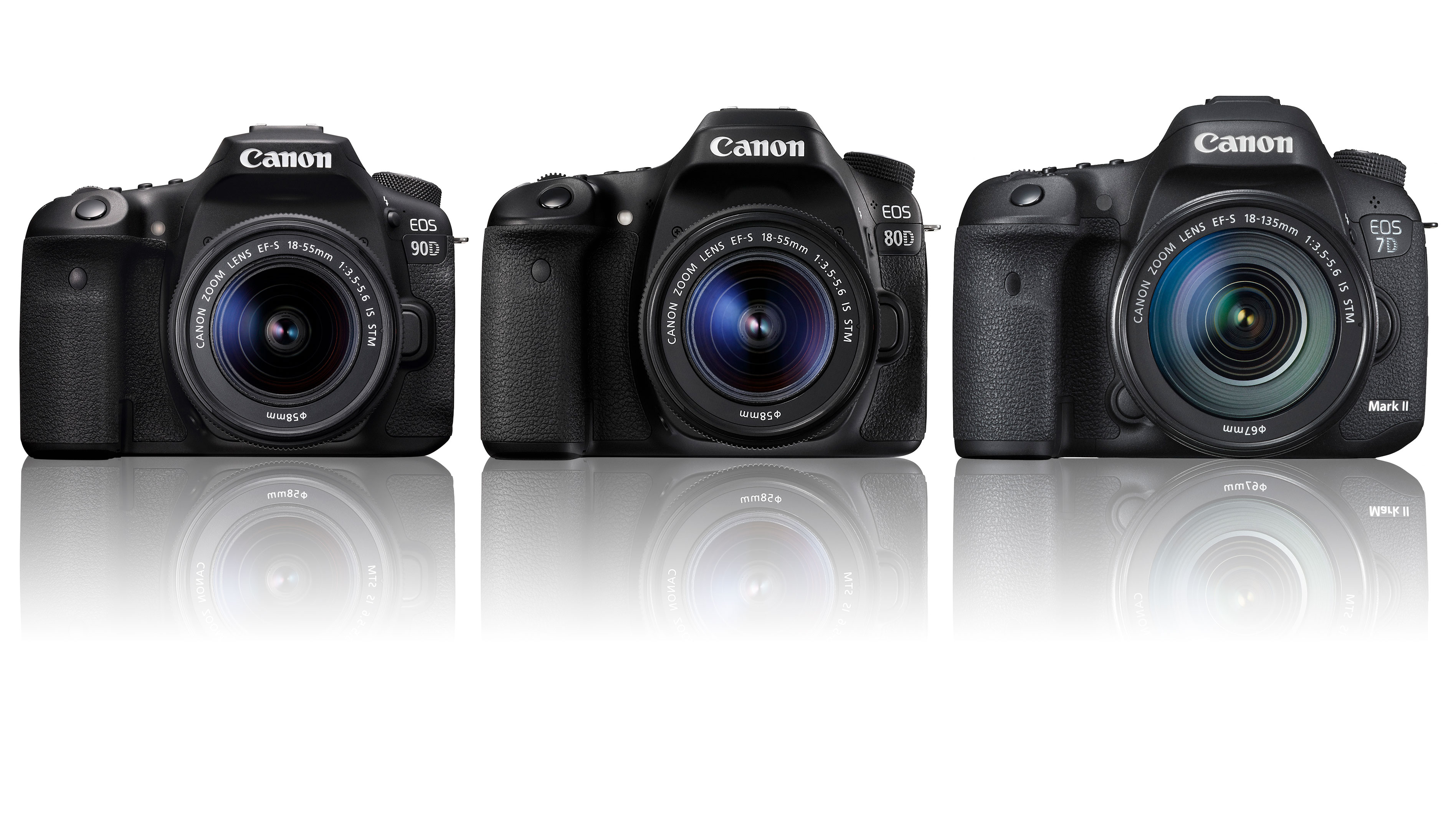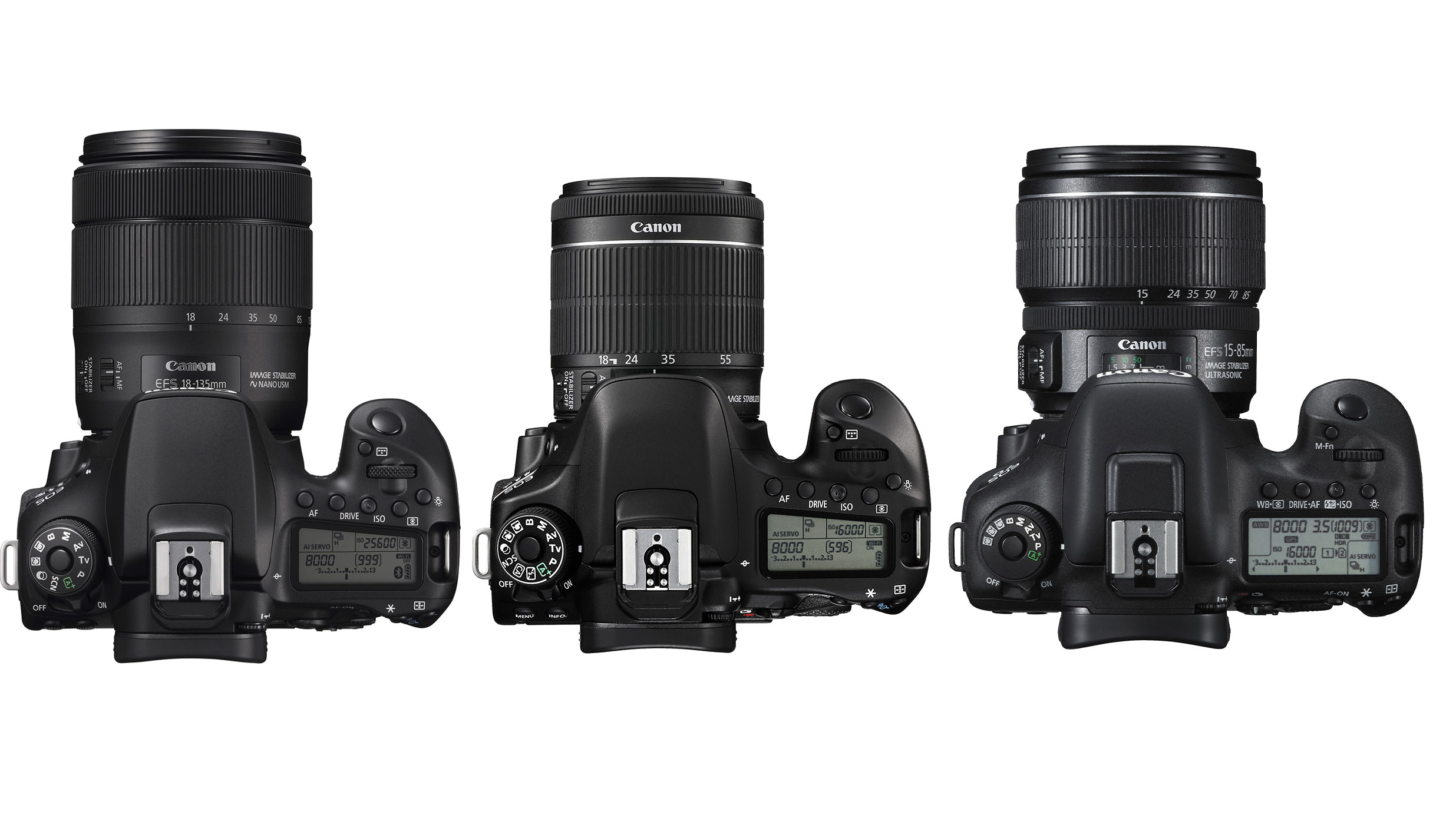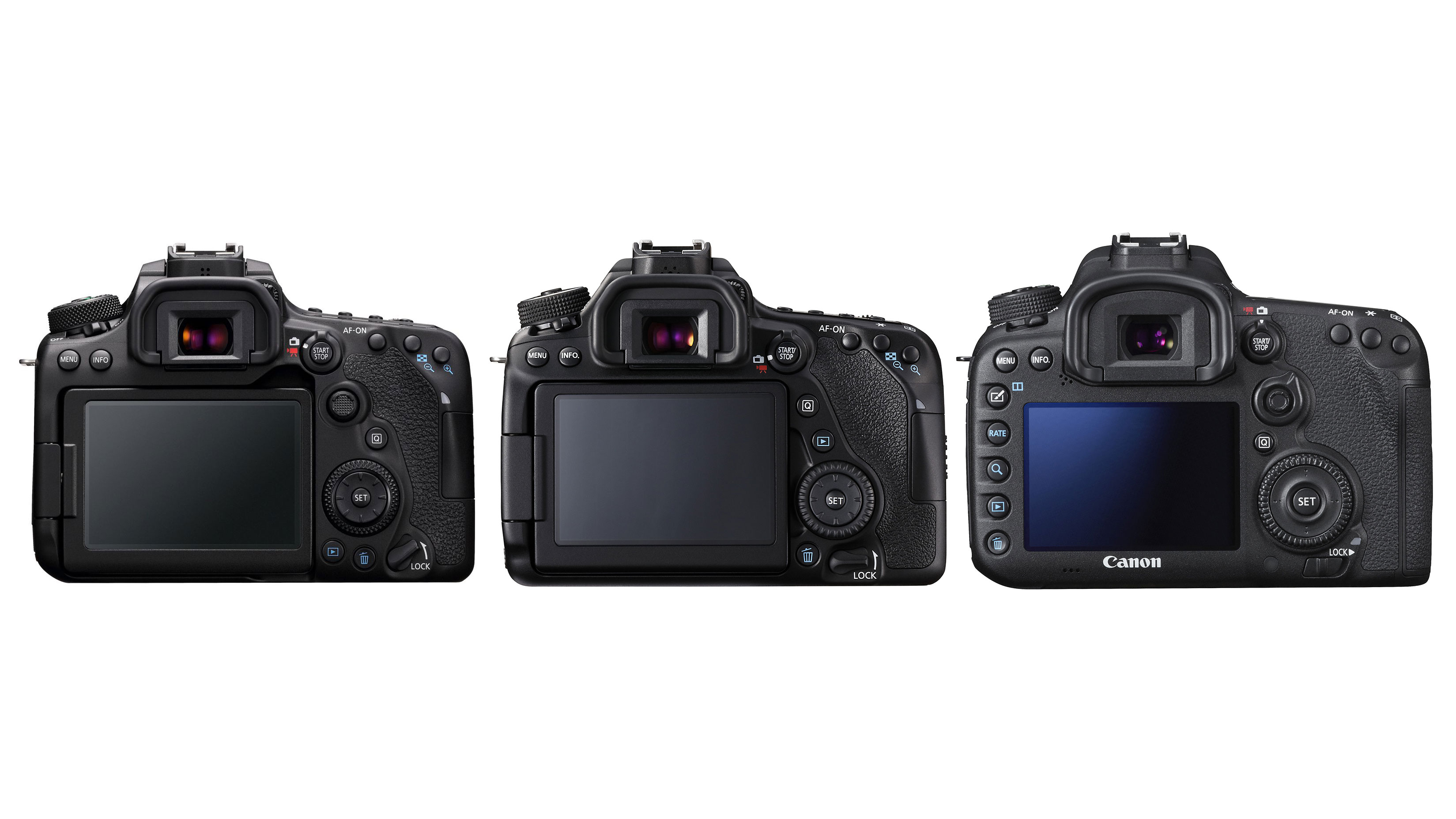Canon EOS 90D vs EOS 80D vs EOS 7D Mark II: 12 key differences
How does Canon’s new DSLR compare with the two cameras it’s replacing? It’s not quite as simple as it looks

The new Canon EOS 90D combines the enthusiast-friendly design of the Canon EOS 80D with the 10fps continuous shooting speed of the Canon EOS 7D Mark II, then adds in a brand new 32.5MP sensor and uncropped 4K video, which are both brand new features. So what’s not to like? This is surely going to be one of the best DSLRs you can get, right?
Update: The Canon EOS 80D is still available from some resellers and territories but is gradually disappearing, and the same is true of the Canon EOS 7D Mark II. However, there are lots of these cameras on the used market, so this is still a comparison worth making. It's especially true for anyone who already owns an EOS 80D or an EOS 7D Mark II and is considering upgrading to the EOS 90D – is it worth it?
But it’s not quite that simple. Canon frequently keeps its older models on sale at discounted prices, so if they already meet your needs you may not need the EOS 90D at all. We also need to check that the new EOS 90D is better than these older models in all respects… so let’s see!
• Read our Canon EOS 90D review
• Canon EOS 90D vs Canon EOS M6 Mark II: how do you choose?
1. Sensor
Why you can trust Digital Camera World
| Canon EOS 90D | Canon EOS 80D | Canon EOS 7D Mark II |
|---|---|---|
| APS-C, 32.5MP | APS-C, 24.2MP | APS-C, 20.2MP |
There’s not much argument here. The sensor in the EOS 90D is brand new, and easily beats the 24.2MP resolution of the EOS 80D and the even lower 20.2MP resolution of the EOS 7D Mark II. The 7D Mark II sensor was designed for speed above resolution, but if the EOS 90D can match that speed and add another 12 million pixels, there doesn’t seem to be much to be said for the ESO 7D Mark II.
2. Processor
| Canon EOS 90D | Canon EOS 80D | Canon EOS 7D Mark II |
|---|---|---|
| DIGIC 8 | DIGIC 6 | DIGIC 6 |
The processor generation isn’t important in itself unless it clearly delivers improved performance. Arguably, the much newer DIGIC 8 processor in the EOS 90D does just that, matching the continuous shooting frame rate of the EOS 7D Mark II, with more than 50% more resolution and increasing the maximum ISO setting at the same time. It also captures 4K video, where the EOS 80D and EOS 7D Mark II do not.
3. ISO range
| Canon EOS 90D | Canon EOS 80D | Canon EOS 7D Mark II |
|---|---|---|
| 100-25,600 (exp 51,200) | 100-16,000 (exp 25,600) | 100-16,000 (exp 51,200) |
Usually, we’d expect a higher resolution sensor of the same physical size to offer a lower maximum ISO, simply because the photosites are smaller. However, Canon has used the latest development in sensor technology and its DIGIC 8 processor to deliver a higher maximum ISO setting AND higher resolution than its predecessors. A higher maximum ISO setting does not guarantee that the image quality will be any good at that setting – we will wait until we can carry out full lab tests before deciding that – but the specs look promising.

4. Video
| Canon EOS 90D | Canon EOS 80D | Canon EOS 7D Mark II |
|---|---|---|
| 4K UHD, 3,840 x 2,160 | FHD, 1,920 x 1,080 | FHD, 1,920 x 1,080 |
| 30p, 25p | 60p, 50p, 30p, 25p | 60p, 50p, 30p, 25p, 24p |
The EOS 90D easily outperforms the older EOS 80D and EOS 7D Mark II for video. It can capture 4K video whereas the older models are restricted to 1080 full HD. Not only that, the EOS 90D can capture 4K uncropped across the full width of the sensor – so it’s also a step ahead of Canon’s previous 4K cameras.
5. Continuous shooting
| Canon EOS 90D | Canon EOS 80D | Canon EOS 7D Mark II |
|---|---|---|
| 10fps | 7fps | 10fps |
| 58 JPEG, 25 RAW | 110 JPEG, 25 RAW | Infinite JPEG, 31 RAW |
Things are a lot closer here. It’s to the credit of the EOS 90D that it can shoot 32.5MP images at 10 frames per second, and this is comfortably ahead of the 7fps of the ESO 80D. But the Canon EOS 7D Mark II can also capture images at 10fps and actually has a slightly better buffer capacity. To be fair, the EOS 90D easily wins for its combination of speed and resolution, but none of these cameras truly have the buffer capacity (at least for raw files) that a serious sports photographer would hope for.
6. Autofocus
| Canon EOS 90D | Canon EOS 80D | Canon EOS 7D Mark II |
|---|---|---|
| 45-point, all cross-type | 45-point, all cross-type | 65-point, all cross-type |
| Dual Pixel CMOS AF | Dual Pixel CMOS AF | Dual Pixel CMOS AF |
All three DSLRs have Canon’s Dual Pixel CMOS AF system, but the EOS 90D has the latest and most sophisticated version. But this only applies for live view shooting and video. For regular ‘viewfinder’ shooting, these cameras will use their regular phase detection AF sensors, and here the EOS 7D Mark II scores a clear win with its 65-point (all cross-type) AF sensor. The new EOS 90D and older EOS 80D have a less sophisticated 45-point AF sensor. Interesting.
7. Memory
| Canon EOS 90D | Canon EOS 80D | Canon EOS 7D Mark II |
|---|---|---|
| SD, SDHC, SDXC (UHS-II) | SD, SDHC, SDXC (UHS-I) | SD, SDHC, SDXC (UHS-I), CF (UDMA 7) |
On paper, the older EOS 7D Mark II might look like it has the advantage here, with two card slots not one. However, one card slot is for the older and near-obsolete CF format, while the other is for UHS I SD cards not UHS II. In fact, despite only having one card slot, the EOS 90D has the edge here since it supports the faster UHS II card format.

8. Viewfinder
| Canon EOS 90D | Canon EOS 80D | Canon EOS 7D Mark II |
|---|---|---|
| Pentaprism, 100% coverage, 0.95x magnification | Pentaprism, 100% coverage, 0.95x magnification | Pentaprism, 100% coverage, 1.0x magnification |
We are perhaps splitting hairs in this comparison. It’s interesting nonetheless that the older EOS 7D Mark II has the best viewfinder, with slightly higher 1.0x magnification compared to the 0.95x viewfinders in the EOS 80D and EOS 90D. Not all progress is forwards.
9. LCD display
| Canon EOS 90D | Canon EOS 80D | Canon EOS 7D Mark II |
|---|---|---|
| 3-inch vari-angle touchscreen | 3-inch vari-angle touchscreen | 3-inch fixed |
| 1.04m dots | 1.04m dots | 1.04m dots |
It’s not such good news for the EOS 7D Mark II here. We’ve got used to tilting screens and vari-angle screens on DSLRs as well as mirrorless cameras, but here we are stuck with a fixed screen on the EOS 7D Mark II. Sports and action fans probably won’t mind too much, but this is a serious limitation for an all-round camera in today’s world.
10. Metering
| Canon EOS 90D | Canon EOS 80D | Canon EOS 7D Mark II |
|---|---|---|
| 220,000-pixel RGB+IR sensor | 7560-pixel RGB+IR sensor | Dual Layer SP |
| 216 segments | 63 segments | 252 zones |
Successful exposure metering depends on the photographer’s judgement and the consistency and predictability of the camera’s metering system as much as the sophistication of the camera’s metering system. For the record, however, the EOS 90D’s metering sensor easily beats resolution of the EOS 80D’s – but the EOS 7D Mark II uses a different dual-layer sensor which operates on a different principle and measures more ‘zones’ than both of the others.
11. Battery
| Canon EOS 90D | Canon EOS 80D | Canon EOS 7D Mark II |
|---|---|---|
| LP-E6N, 1,300 shots | LP-E6N, 960 shots | LP-E6N, 670 shots |
Power management is something of an unseen revolution in digital camera design. All three of these cameras use the same LP-E6N lithium ion battery, but where the EOS 7D Mark II manages a modest 670 shots on this cell, the EOS 80D goes a whole lot longer with 960 shots and the new EOS 90D streaks ahead with a claimed 1,300 shots on a single charge.
12. Dimensions
| Canon EOS 90D | Canon EOS 80D | Canon EOS 7D Mark II |
|---|---|---|
| 140.7 x 104.8 x 76.8mm | 139.0 x 105.2 x 78.5mm | 148.6 x 112.4 x 78.2mm |
| 701g | 730g | 910g |

The EOS 7D Mark II is a bigger, heavier camera than the other two, but that goes with its heavy-duty, high-speed status. The EOS 80D and EOS 90D are smaller, lighter cameras – and the EOS 90D is the lightest of the lot.
Conclusion
The Canon EOS 90D is a fusion of the enthusiast-friendly design of the ESO 80D with the speed of the EOS 7D Mark II, and it adds uncropped 4K video and that class-leading 32.5-megapixel resolution. Not everything has moved forward. The 10fps shooting is great, but the buffer capacity doesn’t quite match that of a true sports camera, and the EOS 90D doesn’t quite have the hefty ruggedness – or the 65-point AF system – of the EOS 7D Mark II. It’s also quite expensive. But as a fusion of two good but ageing DSLRs into a thoroughly modern all-round camera, it’s quite an achievement.
How we test cameras
We test mirrorless and DSLR cameras both in real-world shooting scenarios and in carefully controlled lab conditions. Our lab tests measure resolution, dynamic range and signal to noise ratio. Resolution is measured using ISO resolution charts, dynamic range is measured using DxO Analyzer test equipment and DxO Analyzer is also used for noise analysis across the camera's ISO range. We use these real-world testing and lab results to inform our comments in buying guides. For compact cameras and phones, we judge on real world handling and photographic results alone.
Read more:
• These are the best Canon cameras to buy
• The best DSLRs today
• Looking for your next lens? These are the best Canon lenses to get
• Canon 77D vs 80D
The best camera deals, reviews, product advice, and unmissable photography news, direct to your inbox!

Rod is an independent photography journalist and editor, and a long-standing Digital Camera World contributor, having previously worked as DCW's Group Reviews editor. Before that he has been technique editor on N-Photo, Head of Testing for the photography division and Camera Channel editor on TechRadar, as well as contributing to many other publications. He has been writing about photography technique, photo editing and digital cameras since they first appeared, and before that began his career writing about film photography. He has used and reviewed practically every interchangeable lens camera launched in the past 20 years, from entry-level DSLRs to medium format cameras, together with lenses, tripods, gimbals, light meters, camera bags and more. Rod has his own camera gear blog at fotovolo.com but also writes about photo-editing applications and techniques at lifeafterphotoshop.com
